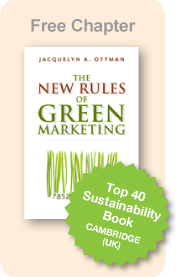Jacquie Ottman's
Green Marketing Blog
The New Green Marketing Paradigm
May 16, 2011 by Jacquelyn Ottman
Conventional marketing is out. Green marketing and what is increasingly being called “sustainable branding” is in. According to the new rules of green marketing, effectively addressing the needs of consumers with a heightened environmental and social consciousness cannot be achieved with the same assumptions and formulae that guided consumer marketing since the postwar era. Times have changed. A new paradigm has emerged requiring new strategies with a holistic point of view and eco-innovative product and service offering.
Historically, marketers developed products that met consumers’ needs at affordable prices and then communicated the benefits of their brands in a memorable way.
Paid media campaigns characterized by ads with catchy slogans were de rigueur. Green or “sustainable” marketing and branding is more complex. It addresses consumers’ new heightened expectations for businesses to operate and requires two strategies:
1. Develop products that balance consumers’ needs for quality, performance, affordability, and convenience with the lowest impact possible on the environment, and with due concern for social considerations, e.g., labor, community.
2. Create demand for the resulting brands through credible, values-laden communications that offer practical benefits while empowering and engaging consumers in meaningful ways about important environmental and social issues. These communications represent value to consumers for what they provide functionally and what they represent, and often positively reinforce the manufacturer’s track record for sustainability as well.
The new rules being laid down by today’s eco-conscious consumers cannot be addressed with conventional marketing strategies and tactics.
Brand builders in the 21st century are accountable to tough new standards. Sustainability represents deep psychological and sociological shifts - not to mention seismically important issues - as did one of its predecessors, feminism, which forced marketers to develop more convenient products in step with two-income lifestyles and to portray women with a new respect.
Meeting the challenges of today’s level of green consumerism presents its own mandates for corporate processes, branding practices, product quality, price, and promotion. To realize that the rules of the game have changed in a big way, one
need only recall the unsavory backlash that is now occurring over what is perceived by environmentalists, regulators, and the press as inconsistent and often misleading eco-labels and messages. The resulting deluge of skepticism, confusion, and regulatory nightmares that spurious green claims - dubbed “greenwash” - are spawning in the marketplace proves that environmental marketing involves more than tweaking one or two product attributes and dressing up packages with meaningless and often misleading
claims. Too many marketers are learning the hard way that leveraging environment-related opportunities and addressing sustainability-related challenges requires a total commitment to greening one’s products and communications.
Green marketing done according to the new rules also affects how a corporation manages its business and brands and interacts with all of its stakeholders who may be affected by its environmental and social practices.
The Seven Strategies for Green Marketing Success
Under the new rules, the currency of sustainable branding is innovation, flexibility, and heart. I have formulated seven strategies which I believe can help businesses address these deep-seated and lasting changes in consumer sensibility. Reflecting our learning from working with sustainability leaders over the past 20-plus years, they can be summarized as follows:
1. Understand the deeply held environmental and social beliefs and values of your consumers and other stakeholders and develop a long-term plan to align with them.
2. Create new products and services that balance consumers’ desires for quality, convenience, and affordability with minimal adverse environmental and social impacts over the life of the product.
3. Develop brands that offer practical benefits while empowering and engaging consumers in meaningful ways about the important issues that affect their lives.
4. Establish credibility for your efforts by communicating your corporate commitment and striving for complete transparency.
5. Be proactive. Go beyond what is expected from stakeholders. Proactively commit to doing your share to solve emerging environmental and social problems - and discover competitive advantage in the process.
6. Think holistically. Underscore community with users and with the broad array of corporate environmental and societal stakeholders.
7. Don’t quit. Promote responsible product use and disposal practices. Continuously strive for “zero” impact.
Excerpted from “The New Rules of Green Marketing: Strategies, Tools, and Inspiration for Sustainable Branding” (Berrett-Koehler, 2011) by Jacquelyn A. Ottman. Copyright © J. Ottman Consulting, Inc.
Jacquie Ottman is founder and principal, of the New York City-based J. Ottman Consulting, Inc. An expert adviser on green marketing to Fortune 500 companies and the U.S. government, she is the author of the newly released, The New Rules of Green Marketing: Strategies, Tools, and Inspiration for Sustainable Branding (Berrett-Koehler, February 2011, 252 pp.) For more information or to download a free chapter, click here



 ShareThis
ShareThis

